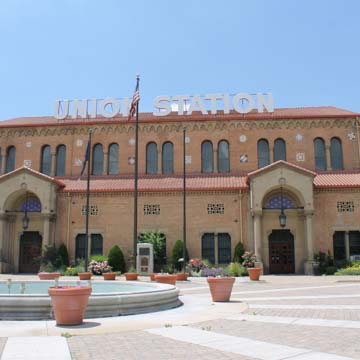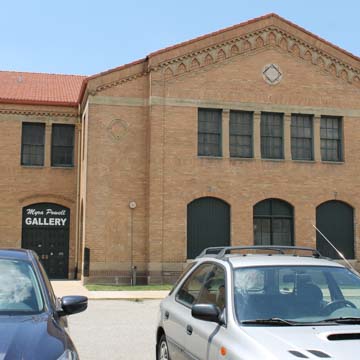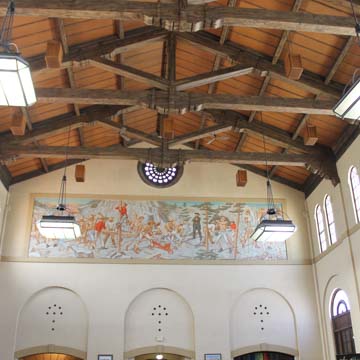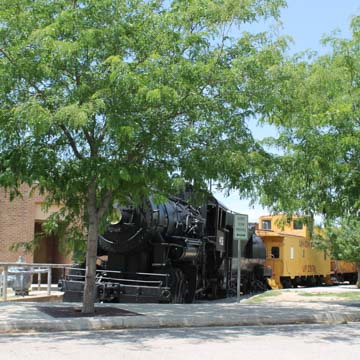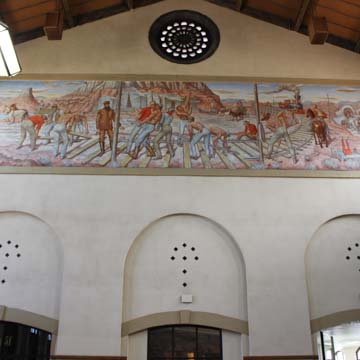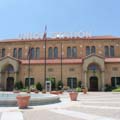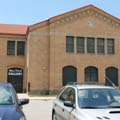You are here
Ogden Union Station
The commanding position of Union Depot along Wall Avenue at the terminus of 25th Street, which runs eastward toward the Wasatch foothills, highlights the importance of the railroads in the development of Ogden, located about thirty-five miles north of Salt Lake City. Once the winter camp of the Shoshone tribes, the area was first settled by Europeans in 1846. With the completion of the transcontinental railroad in 1869, Ogden won the contract to serve as the junction of the Union Pacific and Central Pacific railroads. The town prospered, attracting industrial manufacturing and businesses.
The first Union Station was a small, two-story, wooden structure located on the banks of the Weber River. It was in use from 1869 to 1889. In 1874, the Ogden City Council appropriated $5,000 for a permanent station on higher ground, and the following year Brigham Young, the Mormon President and Governor of the Utah Territory, donated 130 acres for its construction; this second station was not built until 1889. Constructed of local brick and equipped with a large clock tower and many dormers, this Romanesque Revival building was destroyed by fire in 1923. The current Union Station was built on its foundations. The Ogden Union Railway and Depot Company (OUR&D) hired the Los Angeles–based father-and-son team of John and Donald Parkinson to design the new station.
The Parkinsons’ Spanish Colonial Revival design offers an emphasis on horizontality that underscores the lateral thrust of the railways. The complex building program is enclosed in a simple rectangular box, connected to a series of auxiliary structures parallel to the tracks. From the principal facade extrudes two gabled Roman arches with slender Corinthian columns that shelter the entrances, which are illuminated by delicately carved wrought-iron chandeliers. Seven bays of paired arched windows run along the second story. The building’s decorative features include terra-cotta roof tiles, mosaic tile walls, brick grills above entry-level lintels, miniature jambs around the doors, carved archivolts at the entrance, and flushed imposts between arched openings. The two entrance tympanums depict a royal blue sky filled with golden stars; above each entry arch is a round relief of a bison.
The 55-foot-tall grand hall has a checkered tile floor and originally included two rows of wooden benches. Massive wooden trusses support the roof; their hand-hewn edges, which were once painted in bright colors, were stripped of color in 1945–1946. Natural illumination is provided by the clerestory windows along the length of the hall and a small rose window at either gable end. The original massive chandelier has since been replaced with hanging rectangular fixtures that evenly light the hall. Blind arches emphasize the rhythmically placed office and window openings at ground level and the clerestory windows above. Either end of the hall led to office wing and baggage area, respectively.
As elsewhere throughout the country, the station closed in 1977 due to declining rail travel. The City of Ogden leased the station from the Union Pacific for use as a transportation museum. In 1980 the National Academy of Design in New York granted $100,000 to Union Station to commission New York artist Edward Laning to paint two 50 x 12–foot murals based on Wedding of the Rails (1935), a mural originally installed at the Ellis Island Immigration Station. Laning painted the murals in his New York City studio and shipped them to Odgen, where he supervised the installation. The murals depict construction of the railroad by European and Chinese laborers. This was Laning’s last major work before his death in 1981.
The State of Utah designated Union Station the Utah State Railroad Museum in 1988, and the building is now also home to the John M. Browning Firearms Museum, the Browning-Kimball Classic Car Museum, the Myra Powell Art Gallery, and since 2013, the Utah Cowboy and Western Heritage Museum.
References
Writing Credits
If SAH Archipedia has been useful to you, please consider supporting it.
SAH Archipedia tells the story of the United States through its buildings, landscapes, and cities. This freely available resource empowers the public with authoritative knowledge that deepens their understanding and appreciation of the built environment. But the Society of Architectural Historians, which created SAH Archipedia with University of Virginia Press, needs your support to maintain the high-caliber research, writing, photography, cartography, editing, design, and programming that make SAH Archipedia a trusted online resource available to all who value the history of place, heritage tourism, and learning.

